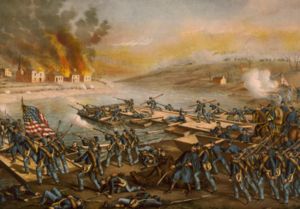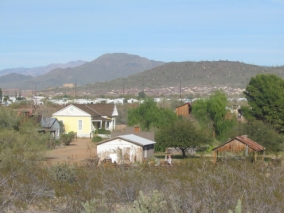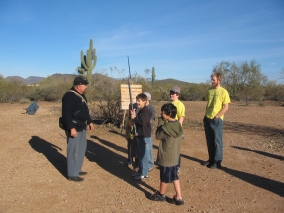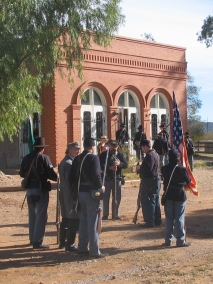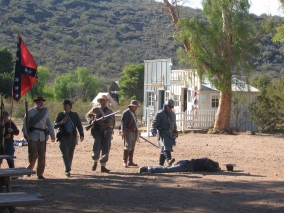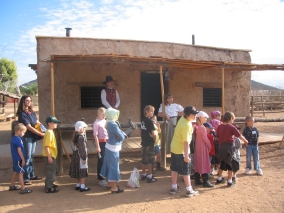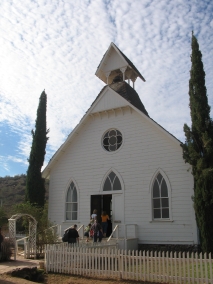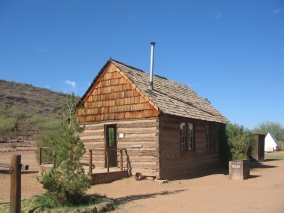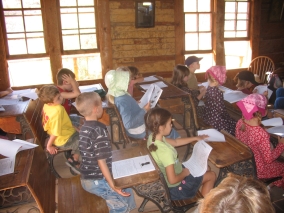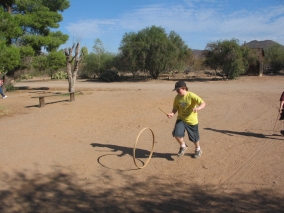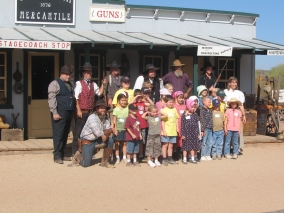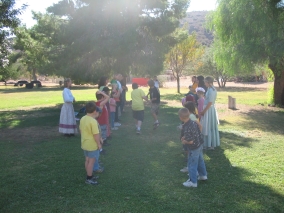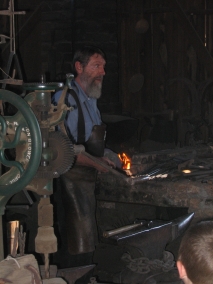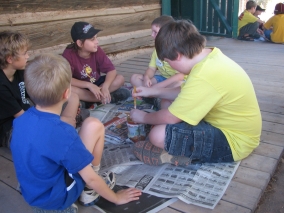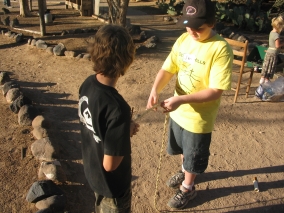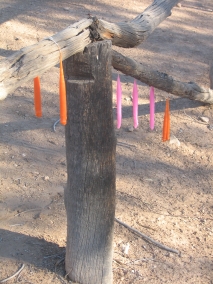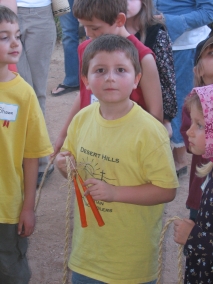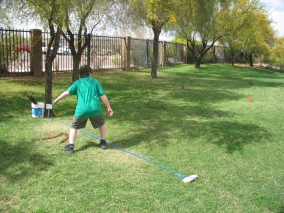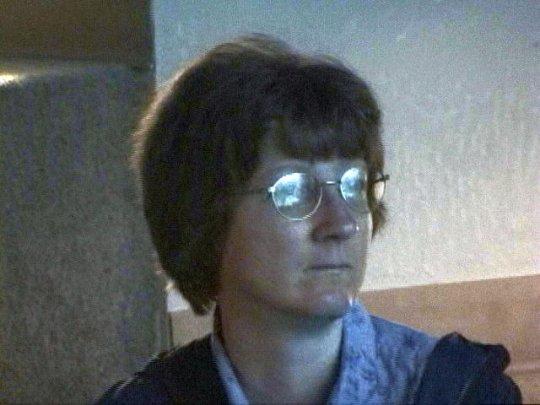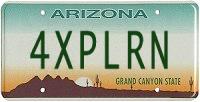CIVIL WAR DEMO~ January 12, 2008
American Civil War, December 1862: Major General Ambrose Burnside, in command of the Union Army of the Potomac, sent troops to occupy the vicinity of
Public Domain Image: Battle of Fredericksburg by Kurz and Allison
Several families in our homeschool group stepped back in time to the day when the Union Army attacked the town of Fredericksburg in December 1862. The boys in particular really got into it and had a blast! The Battle of Fredericksburg re-enactment took place at
Considering all of the unusually rainy weekends we've had lately, we were lucky that it was a beautiful clear winter day. The re-enactors said that it was perfect weather for wearing their wool uniforms - but even so, they still got hot marching out there under the bright desert sun!
We arrived at 9:00 am when the gates opened and that gave us plenty of time to visit the Union soldiers' camp before the fighting began. Both Union and Confederate re-enactors are a great bunch of guys, eager to offer information and answer questions.
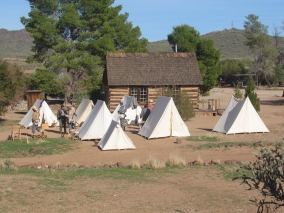
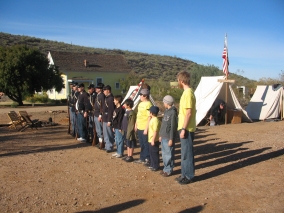 The troops would practice loading their weapons, attaching bayonets, and performing various maneuvers. The boys in our group lined up to drill with the soldiers.
The troops would practice loading their weapons, attaching bayonets, and performing various maneuvers. The boys in our group lined up to drill with the soldiers.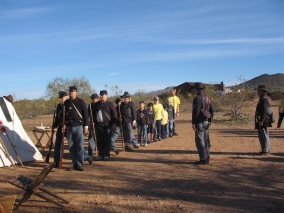 "The first thing in the morning is drill. Then drill, then drill again. Then drill, drill, a little more drill. Then drill, and lastly drill."
"The first thing in the morning is drill. Then drill, then drill again. Then drill, drill, a little more drill. Then drill, and lastly drill."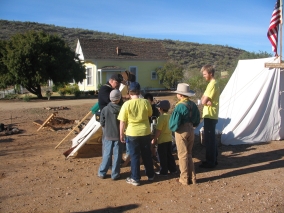 Live demonstrations focused on Weapons, Cooking, and
Live demonstrations focused on Weapons, Cooking, and 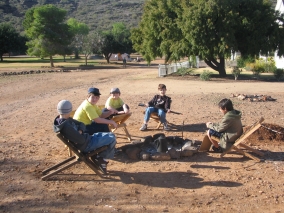 Relaxing around the campfire. When not drilling, standing guard, or faced with the sheer terror of battle, soldiers would spend their spare time reading, writing letters to loved ones, playing cards and other games.
Relaxing around the campfire. When not drilling, standing guard, or faced with the sheer terror of battle, soldiers would spend their spare time reading, writing letters to loved ones, playing cards and other games.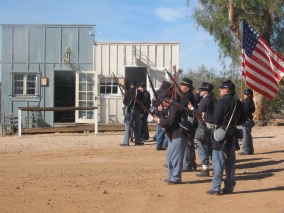 Union troops getting ready for action. It was a great honor to be the flag bearer and when a flag bearer fell in battle, someone else would leap forward to take his place. But their mortality rate was quite high since the goal of the opposing force was to seize the enemies' colors.
Union troops getting ready for action. It was a great honor to be the flag bearer and when a flag bearer fell in battle, someone else would leap forward to take his place. But their mortality rate was quite high since the goal of the opposing force was to seize the enemies' colors.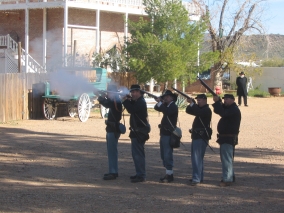 The Union Troops Advance Through Fredericksburg!
The Union Troops Advance Through Fredericksburg!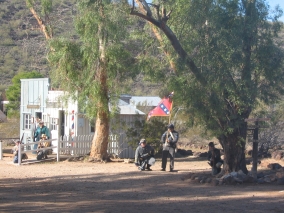 Confederate citizens either went into hiding, ran away, or prepared to defend their homes and businesses as the Union army invaded their town.
Confederate citizens either went into hiding, ran away, or prepared to defend their homes and businesses as the Union army invaded their town.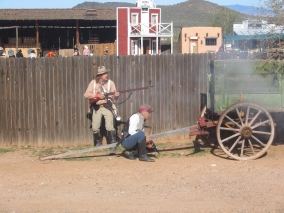 Some of the townspeople got involved in the street fight. (It was an exciting interactive experience for the spectators, too. A gang of boys - mine included! - ran after the Union army, tossing rolled-up newspaper "rocks" at them, but there was so much commotion at the time that I didn't get a picture of that!)
Some of the townspeople got involved in the street fight. (It was an exciting interactive experience for the spectators, too. A gang of boys - mine included! - ran after the Union army, tossing rolled-up newspaper "rocks" at them, but there was so much commotion at the time that I didn't get a picture of that!)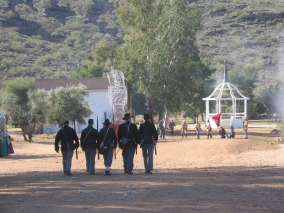 The Confederate troops fall back as the Union army advances. (Newspaper ball "rocks" can be seen on the ground behind them.)
The Confederate troops fall back as the Union army advances. (Newspaper ball "rocks" can be seen on the ground behind them.)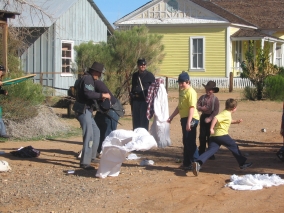 Union soldiers ransacked the town (and got back at the boys who had pelted them with "rocks" by throwing ladies' clothing at them).
Union soldiers ransacked the town (and got back at the boys who had pelted them with "rocks" by throwing ladies' clothing at them).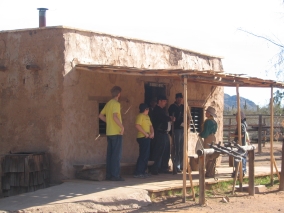 Hanging out at the Sheriff's Office.
Hanging out at the Sheriff's Office.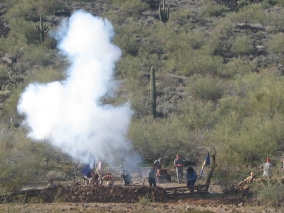 The Union Army's orders were: "Push a column of a division or more along the Plank and Telegraph roads, with a view to seizing the heights in the rear of the town." In the battle of Marye's Heights, Union troops tried to take the hill, but the Confederates were already entrenched behind a stone wall.
The Union Army's orders were: "Push a column of a division or more along the Plank and Telegraph roads, with a view to seizing the heights in the rear of the town." In the battle of Marye's Heights, Union troops tried to take the hill, but the Confederates were already entrenched behind a stone wall.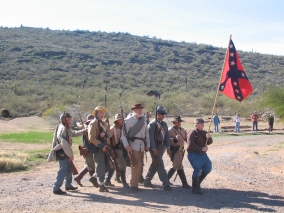 Confederate troops on the march.
Confederate troops on the march.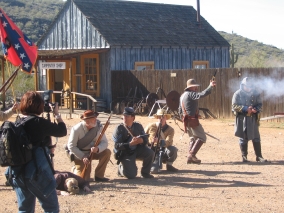
The Confederates are victorious, and the Union Army retreats. The actual battles lasted from approximately 10:30 - 2:30 with a lunch break in between. We stayed for a while afterwards to wander around and chat with the Confederate soldiers, then left at 3:00 pm although we could have stayed until 5:00.
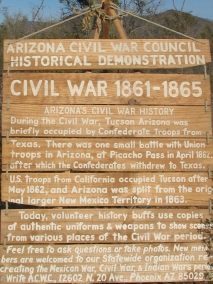
This event was sponsored by the Arizona Civil War Council, Inc. The Arizona Civil War Council (ACWC) is a non-profit association of volunteer history enthusiasts who re-enact events of the Civil War and
WANTED:
Did you know...? Gods & Generals (the prequel to the hit movie
Additional Info:
http://en.wikipedia.org/wiki/Battle_of_Fredericksburg
http://www.nps.gov/frsp/fire.htm - Fire in the Streets
http://www.nps.gov/frsp/assault.htm
http://www.nps.gov/archive/gett/soldierlife/cwarmy.htm - What was life as a Civil War soldier like? Get more details in this fascinating article from
Labels: battle, Civil War, history, Living History, Museum, Pioneer Village, reenactors

